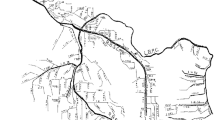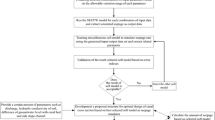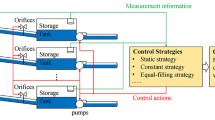Abstract
Chiyoda basin is located in Saga Prefecture in Kyushu Island, Japan, and lies next to the tidal compartment of the Chikugo River to which the excess water in the basin is drained away. Chiyoda basin has a total area of about 1,100 ha and is a typical flat and low-lying paddy-cultivated area. The main problem in this basin is the appropriate operation of drainage structures during and after flood events in order to minimize the inundation damages for crop yield and to fulfill the irrigation requirement in the irrigation period. This paper presents a mathematical model of a drainage system in Chiyoda basin for calculating the flood inundation and optimizing the operation of gates in a main drainage canal. First, the algorithm of gate operation was simulated and the drainage model was then evaluated by comparing the simulated water levels with those observed during an actual rainfall event. The results show that the observed and simulated water levels are in good agreement, indicating that the proposed model is applicable for drainage and inundation analyses in flat, low-lying paddy-cultivated areas. Second, the optimization of gate operation was investigated by trial and error method using a stochastic rainfall time series with a return period of 30 years and the tidal conditions of spring and neap tides in the Chikugo River. Comparing a total inundation time, a total inundation area and maximum inundation depth in the paddy tanks at the upstream and the downstream ends, it was concluded that the present operation based on the gate operators’ experience was almost the optimal one, and the sooner start of opening operation and the later start of closing operation within the operationality of check gates were recommended to minimize the inundation damage. The present operation could be able to minimize the total inundation time, the total inundation area and the maximum inundation depths in paddy tanks and to meet fully both the drainage and the irrigation requirements.
















Similar content being viewed by others
References
Chen RS, Pi LC (2004) Diffusive tank model application in rainfall-runoff analysis of upland fields in Taiwan. Agric Water Manag 70:39–50
Chen RS, Pi LC, Huang Y (2003) Analysis of rainfall-runoff relation in paddy fields by diffusive tank model. Hydrol Process 17:2541–2553
Chinh LV, Hiramatsu K, Harada M, Mori M (2005) Optimal gate operation of a main drainage canal in a flat, low-lying agricultural area using a tank model incorporated with a genetic algorithm. J Fac Agric Kyushu Univ 51(2):351–359
Chow VT (1986) Open-channel hydraulics. McGraw-Hill Book Company, New York, pp 109–123
Dutta D, Herath S, Musiake K (2006) An application of flood risk analysis system for impact analysis of a flood control plan in a river basin. Hydrol Process 20:1365–1384
Durdu OF (2006) Use control of transient flow in irrigation canal using Lyapunov fuzzy filter-based Gaussian regulator. Int J Numer Methods Fluids 50:491–509
Ghumman AR, Khan MZ, Khan MJ (2006) Use of numerical modelling for management o canal irrigation water. Irrig Drain 55:445–458
Hiramatsu K, Shikasho S, Kurosawa K, Mori M (2004) Drainage and inundation analysis in a flat, low-lying, paddy-cultivated area of the Red River Delta of Vietnam. J Fac Agric Kyushu Univ 49(2):383–399
Hsu MH, Chen SH, Chang TJ (2000) Inundation simulation for urban drainage basin with storm sewer system. J Hydrol 234:21–37
Overton IC (2005) Modelling floodplain inundation on a regulated river: integrating GIS, remote sensing and hydrological models. River Res Appl 21:991–1001
Pappenberger F, Beven K, Horritt M, Blazkova S (2005) Uncertainty in the calibration of effective roughness parameters in HEC-RAS using inundation and downstream level observations. J Hydrol 302:46–69
Ruiguang H, Suryadi FX (2004) Flood control and land use management in Mengwa Retention area, Huai river basin. Irrig Drain 53:385–395
Shikasho S, Tanaka K (1985) Runoff analysis of low-lying drainage basins in Japan. Irrig Eng Rural Plan 8:5–17
Stewart MD, Bates PD, Andreson MG, Price DA, Burt TP (1999) Modelling floods in hydrologically complex lowland river reaches. J Hydrol 223:85–106
Acknowledgments
The authors wish to acknowledge the Chikugo River Basin Irrigation and Drainage Project Office, Kyushu Regional Agricultural Administration Office, the Ministry of Agriculture, Forestry and Fisheries of Japan for the acquisition of the in situ measurement data of the water levels in the main drainage canal. We appreciate the helpful cooperation in modeling the drainage network in Chiyoda basin provided by Gijutsu Kaihatsu Consultant Co., Ltd, Fukuoka, Japan. Partial financial support for this study was provided by JSPS Grants-in-Aid for Scientific Research (B) (project numbers: 16380163 and 19380138). We would also like to thank all of the project members for their invaluable discussions.
Author information
Authors and Affiliations
Corresponding author
Rights and permissions
About this article
Cite this article
Van Chinh, L., Hiramatsu, K., Harada, M. et al. Optimal gate operation of a main drainage canal in a flat, low-lying, agricultural area using a tank model. Paddy Water Environ 6, 243–256 (2008). https://doi.org/10.1007/s10333-008-0129-7
Received:
Accepted:
Published:
Issue Date:
DOI: https://doi.org/10.1007/s10333-008-0129-7




